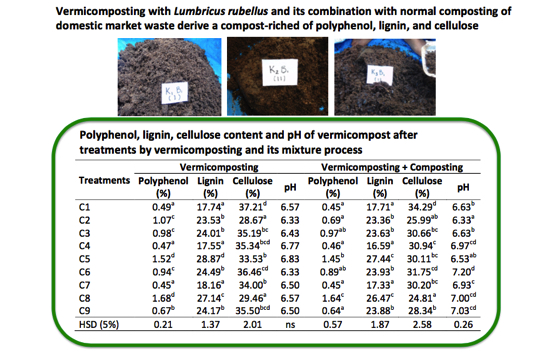Chemical Composition of Vermicompost Made from Organic Wastes through the Vermicomposting and Composting with the Addition of Fish Meal and Egg Shells Flour
Abstract

Chemical composition of compost is an important indicator that determines the quality of compost. This study compared the chemical composition of vermicompost resulting from the process of vermicomposting alone with combined vermicomposting and composting with addition of egg shells flour and fish meal. Organic wastes used were the mixture of spent mushrooms waste, coconut husks, cow dung, vegetables residue, and leaf litter. Lumbricus rubellus was the species of earthworm used in the vermicomposting process. In the composting process, egg shells flour and fish meal are added into the vermicompost as additives materials. The results indicate that the combined vermicomposting and composting process with addition the additives materials improves the chemical composition of vermicompost compared to using vermicomposting process alone. The change of chemical composition was indicated by a decrease in C-organic content and C/N ratio by 29% and 99%, respectively, while the content of N, P, K and S increased by 52%, 67.5%, 29% and 25%, respectively due to the addition of additives material in the composting process. The largest increase of vermicompost nutrient content occurred in the Ca content by an average of up to 7-fold. While polyphenols, lignin and cellulose content of vermicompost decreased slightly. The treatment of two mixture (a) spent mushrooms waste, cow dung and vegetables residue, and (b) spent mushroom waste, cow dung, vegetables residue, and leaf litter gave the best chemical composition. However, to determine the quality, we need to test the product in a plant growth bioassay as a follow-up study.
References
[1] Ministry of Environment, 2015. Arrangement waste management regulations. http://www.menlh.go.id. Accessed on September 21st, 2016.
[2] The Center for Agriculture, Food and the Environment. 2016. “Waste Management and Composting”. The UMass Center for Agriculture, Food and the Environment is the home of UMass Extension and the Mass. Ag. Experiment Station. CDLE Pub.09-57. https://ag.umass.edu/fact-sheets/waste-management-composting. Accessed on September 21st, 2016.
[3] Jenkins, J. Thermophilic Composting as A Sanitation Alternative Givelove Org Project, Santo Village, Leogane, Haiti – A Case Study. 2015. Postal address : 143 Forest Lane, Grove City, PA 16127 USA.
[4] Alidadi, H., A.R. Parvaresh, M.R. Shahmansouri, and H.Pourmoghadas, Iran. J. Environ. Health. Sci. Eng., 2005, 2, 251-254.
[5] Dominguez, J. and C. A. Edwards, Biology and Ecology of Earthworm Species Used for Vermicomposting, 2011, Taylor & Francis Group, LLC. p.27-40.
[6] Gandhi, M., V. Sangwan, K.K. Kapoor, and N. Dilbaghi, Environ. Ecol., 1997, 15(2), 432 – 434.
[7] Elvira, C., J. Domínguez, and S. Mato, Appl. Soil Ecol., 1996, 5, 97–103.
[8] Atiyeh, R. M., N. Arancon, C. A. Edwards, and J. D. Metzger, Bioresour. Technol., 2000, 75, 175-180.
[9] Monroy, F., M.Aira, and J. Dominguez, Appl. Soil Ecol, 2008, 39, 127-132.
[10] Aira, M., L. Sampedro, F. Monroy, and J. Domínguez, Soil Biol. Biochem., 2008, 40, 2511–2516.
[11] Aira, M., M. Gómez-Brandón, C. Lazcano, E. Baath, and J. Domínguez, Soil Biol. Biochem., 2010, 42, 12, 2276-2281.
[12] Lavelle, P. and A.V. Spain, Soil Ecology, 2001, Kluwer Academic Publishers Dordrecht, Dordrecht, Netherland.
[13] G. Neata, R. Teodorescu, L. Dinca, A. Basaraba, Agric. Agric. Sci. Procedia., 2015, 6, 486-491.
[14] Khan, A., and F. Ishaq, Asian J Plant Sci Res, 2011, 1 (1), 116-130.
[15] Ndegwa, P. M., and S. A. Thompson, Bioresour. Technol., 2001, 76, 107-112.
[16] Ndegwa, P. M., Thompson, S. A. Das, K. C., Bioresour. Technol., 1999, 71(1), 5-12.
[17] Soil Survey Staf, Soil survey laboratory methods manual, Soil survey Investigations Report 42, 1992, USDA-SCS, National Soil Survey Center, Lincoln, NE.
[18] Schulte, E. E. and R. B. Corey, Soil Sci Soc Am Pro, 1963, 27, 358-360.
[19] Verma, B. C., K. Swaminathan, and K. C. Sud, Talanta, 1977, 29, 49-50.
[20] Anderson, J. M. and J. S. I. Ingram, Tropical Soil Biology and Fertility : A Handbook of Methods of Analysis, 1993, Second Edition, CAB International, 157(4), 98-109.
[21] Hui, Z., L. Jianhua, D. Jianqing, C. Meiyuan, and C. Yi, The alternative uses of spent mushroom compost, 2007, Fujian mushroom R&D Station, 350005, Fuzhou, P.R. China. www.tuinbouw.nl/sites/default/files/documenten/00026610.pdf, Accessed on September 21st, 2016.
[22] Majlessi, M., A. Eslami, H.N. Saleh, S. Mirshafieean, and S. Babaii, Iranian J Environ Health Sci Eng., 2012, 9, 1-6.
[23] Lores, M., M. Gomez-Brandon, D. Perez-Diaz, and J. Dominguez, Soil Biol. Biochem, 2006, 38, 2993-2996.
[24] Hoitink, H. A. J. and M. J. Boehm, Annual Rev Phytophatol, 1999, 37, 427-446.
[25] Jimenez, E. I. and V. P. Garcia, Biol Waste, 1992, 27, 115-142.
[26] Erhart, E. and K. Burian, Compost Sci. Util., 1997, 5, 15-24.
[27] Brewer, L.I. and D.M. Sullivan, Compost Sci. Util., 2003, 11, 96-112.
[28] Gomez-Brandon, M., C. Lazcano, and J. Domingueza, Chemosphere, 2008, 70, 436-444.
[29] Dominguez, J., The Microbiology of Vermicomposting, 2011, Taylor & Francis Group, LLC.
[30] Frankenberger, W .T. and H. M. Abdelmagid, Plant Soil, 1985, 87, 257-271.
[31] Thomas, M. B. and M. I. Spurway, Combined Proceedings International Plant Propagators Society, 1998, 48, 66-71.
[32] Igbokwe, P. K., C. O. Asadu, E. C. Okpe, and S. E. Okoro, Int. J. Novel Res. Phys. Chem. Mathematics, 2015, 2 (3), 6-15.
[33] Mtambanengwe, F. and H. Kirchmann, Soil Biol. Biochem, 1995, 27, 1639-1651.
[34] Tian, G. L., Brussaard, and B. T. Kang, Applied Soil Ecol.1995, 2, 25-32.
[35] Darlington, W., Soil& Plant Laboratory, Inc. Orange Office, 2007, 714, 282-877.
[36] Walton, H. V. and O. J. Cottrill, Poult Sci, 1972, 51, 1884.
[37] Ahmad, R., A. Khalid, and M. Mahmood, Pak J Bot, 2007, 39 (2), 541-549.
[38] Louisa, M. A., and G. Taguiling, ESJ, 2013. 9 (36), 319-341.
[39] Yasothai, R. and N.V. Kavithaa, IJEST, 2014, 3(4), 1436-1439.
[40] Khan, T.A., N. Khan, M. Ashraf, N.A. Qureshi, M.S.Mughal, and G. Abbas, J. Vet. Anim. Sci, 2012, 2, 65-71.
[41] Ponce, L.E. and A.G. Gernat, Poult Sci, 2002, 81, 1045-1049.
Refbacks
- There are currently no refbacks.

This work is licensed under a Creative Commons Attribution-NonCommercial 4.0 International License.








